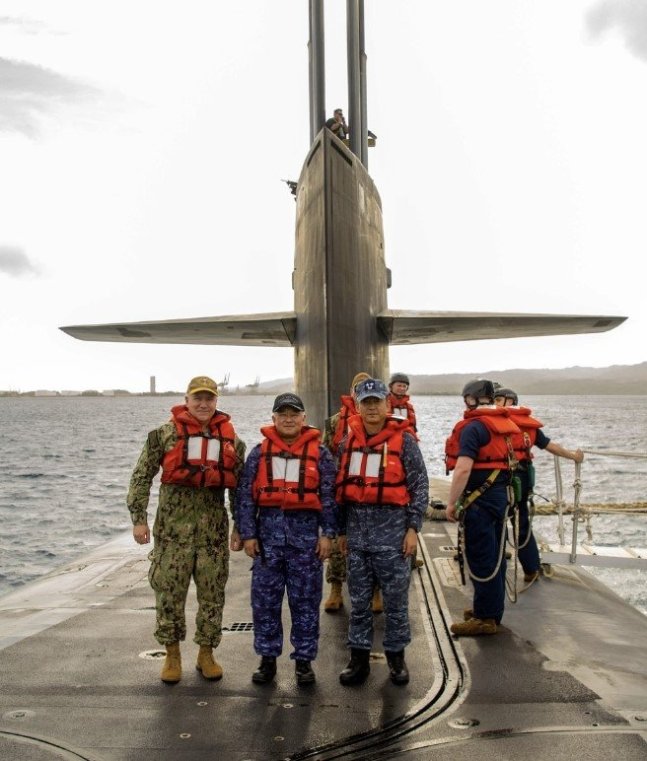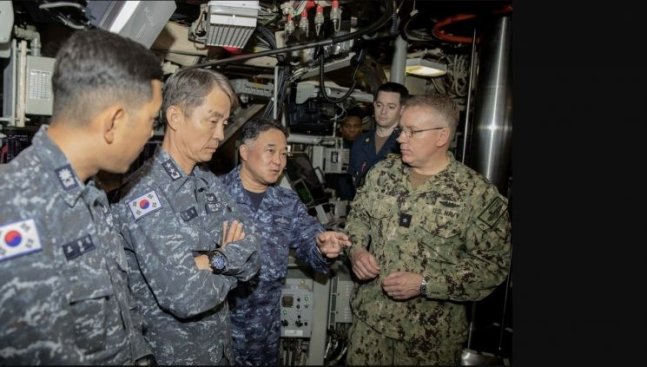It was belatedly disclosed that submarine commanders from South Korea, the U.S., and Japan boarded a U.S. strategic nuclear submarine (SSBN) together for the first time. Previously, the leaders of South Korea and the U.S. announced the SSBN’s domestic port call within a few weeks as a follow-up measure to the “Washington Declaration” to strengthen extended deterrence against North Korea.
On the 18th of last month, the U.S. Department of Defense through the Defense Video Information Distribution Service (DVIDS) announced that ROK Navy Submarine Commander Lee Soo-yeol (Admiral), US 7th Submarine Flotilla Commander (Commodore) Rick Schiff, and Japan Maritime Self-Defense Force Submarine Fleet Commander (Lieutenant General) Tateki Tarawa. ) announced that they had visited the Guam base and boarded the US Navy’s Ohio-class SSBN ‘Main Ship (18,750t)’. “This boarding reflects our special relationship with South Korea and Japan and our iron-clad commitments to our respective allies,” Schiff said.
 Navy Submarine Commander Lee Soo-yeol (Major General, far right) boarded the US Strategic Nuclear Submarine (SSBN) ‘Main’ operating at the Guam base on the 18th of last month, Rick Schiff, commander of the US 7th Submarine Flotilla (far left), and Tateki Tarawa. Taking a commemorative photo with the commander of the Japanese Maritime Self-Defense Force’s submarine fleet. Source US Department of Defense Defense Imaging Information Distribution Service (DVIDS)
Navy Submarine Commander Lee Soo-yeol (Major General, far right) boarded the US Strategic Nuclear Submarine (SSBN) ‘Main’ operating at the Guam base on the 18th of last month, Rick Schiff, commander of the US 7th Submarine Flotilla (far left), and Tateki Tarawa. Taking a commemorative photo with the commander of the Japanese Maritime Self-Defense Force’s submarine fleet. Source US Department of Defense Defense Imaging Information Distribution Service (DVIDS)A military official said, “Commander Lee’s visit to the Guam base is to confirm the US’s extended deterrence capability in response to North Korea’s advancement of nuclear missiles and to strengthen exchanges and cooperation among the commanders of the submarine forces of the three countries.” He continued, “Through this visit, I was able to reaffirm the firm security commitment and capabilities of the United States to the Republic of Korea.”
SSBNs are considered one of the three major nuclear forces of the United States along with intercontinental ballistic missiles (ICBMs) and strategic bombers. Having commanders from both Korea and Japan board the SSBN, the most secretive nuclear force, is interpreted as sending a strong warning message to North Korea by showing off the robustness of the ROK-US alliance and military cooperation between the US and Japan.
 Navy Submarine Commander Lee Soo-yeol (Major General, second from left) boarded the US Strategic Nuclear Submarine (SSBN) ‘Main’ operating at Guam on the 18th of last month, and Rick Schiff, commander of the US 7th Submarine Flotilla (far right), and Tarawata Tekki, Japan Maritime Self-Defense Force Submarine Fleet Commander (second from right) exchanges opinions. Source US Department of Defense Defense Imaging Information Distribution Service (DVIDS)
Navy Submarine Commander Lee Soo-yeol (Major General, second from left) boarded the US Strategic Nuclear Submarine (SSBN) ‘Main’ operating at Guam on the 18th of last month, and Rick Schiff, commander of the US 7th Submarine Flotilla (far right), and Tarawata Tekki, Japan Maritime Self-Defense Force Submarine Fleet Commander (second from right) exchanges opinions. Source US Department of Defense Defense Imaging Information Distribution Service (DVIDS)The Ohio-class SSBN, whose main mission is to perform a second strike (nuclear retaliation) in the event of an enemy nuclear attack, is a submarine equipped with a 5-7kt (kiloton, 1kt is equivalent to 1,000 tons of TNT) class low-power nuclear warhead to a 475kt hydrogen bomb-class nuclear warhead. Up to 24 launch ballistic missiles (SLBMs) can be installed. In the case of the Trident-2 SLBM, the maximum range is 12,000 km, so it can hit anywhere on the earth within 30 minutes.
On the 26th of last month, the day before the summit between President Yoon Seok-yeol and US President Joe Biden, the United States released an unusual photo of the “Mainham” entering the Guam base.
Some observe that the main ship will visit Korea in time for the G7 summit to be held in Hiroshima, Japan, from the 19th to the 21st.
Yoon Sang-ho, military reporter [email protected]
Source: Donga
Mark Jones is a world traveler and journalist for News Rebeat. With a curious mind and a love of adventure, Mark brings a unique perspective to the latest global events and provides in-depth and thought-provoking coverage of the world at large.